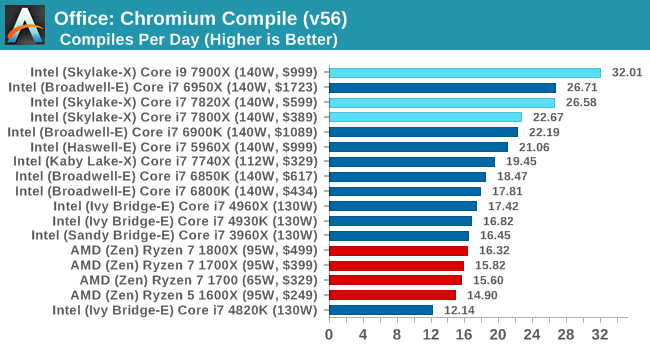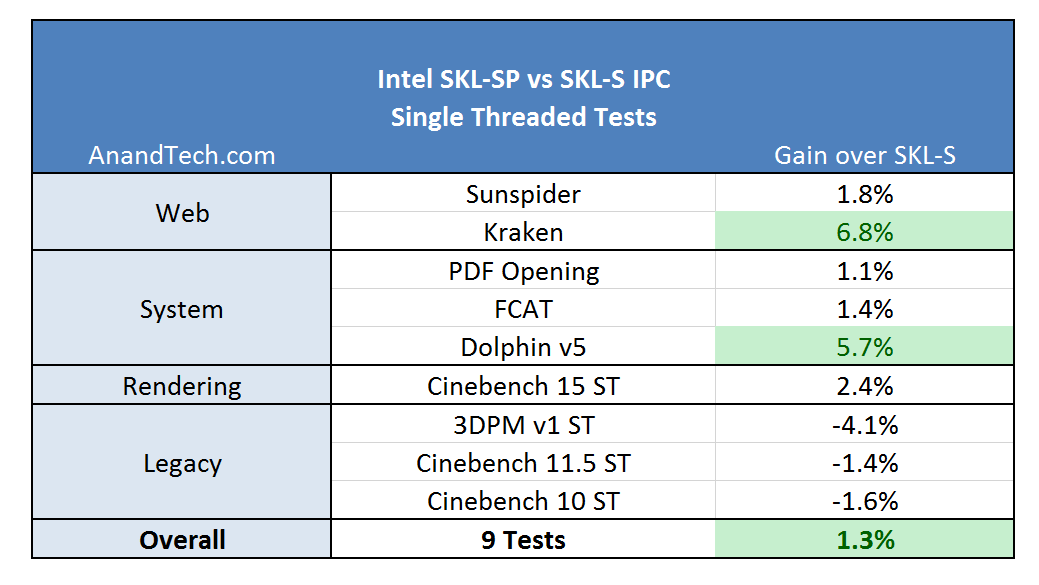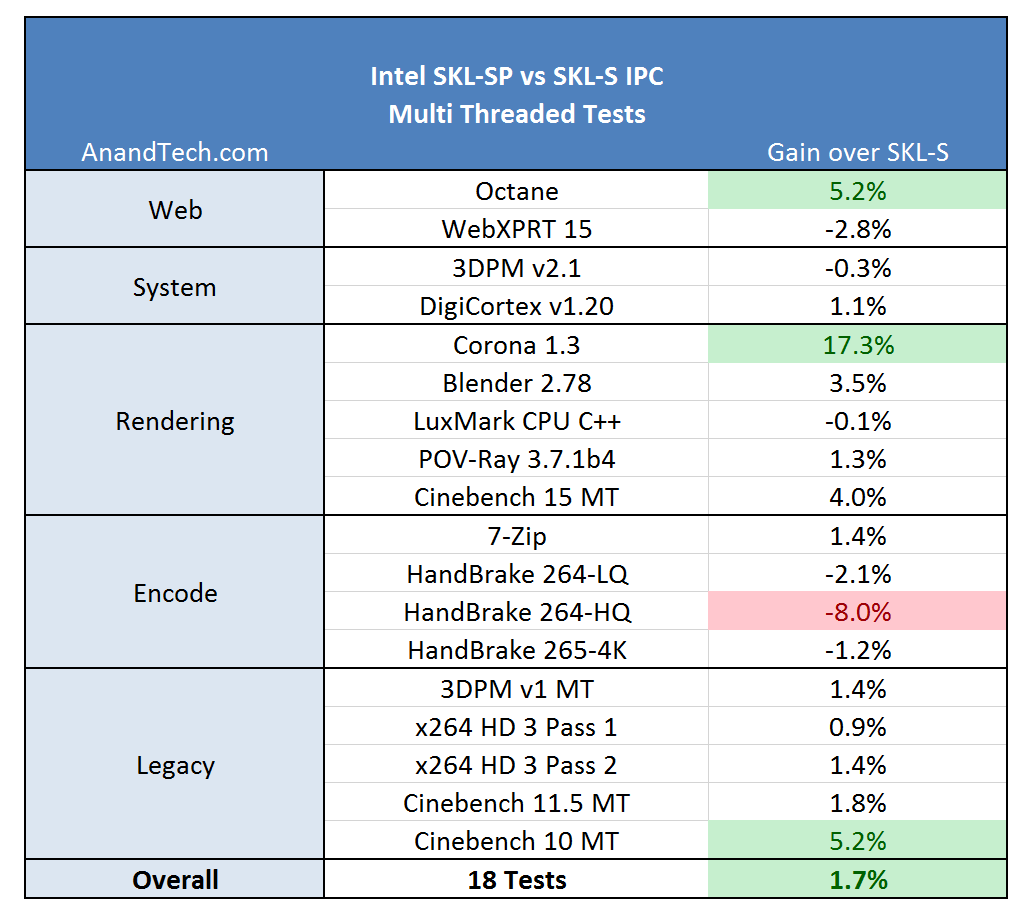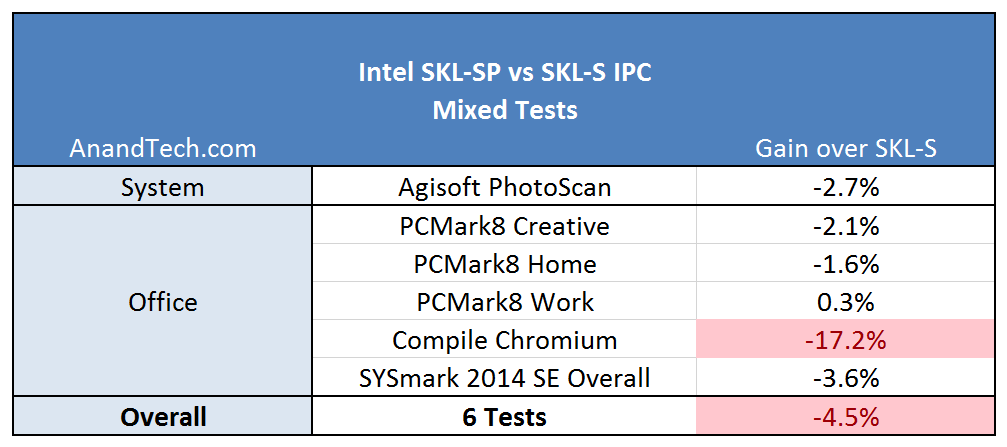The Intel Skylake-X Review: Core i9 7900X, i7 7820X and i7 7800X Tested
by Ian Cutress on June 19, 2017 9:01 AM ESTComparing Skylake-S and Skylake-X/SP Performance Clock-for-Clock
If you’ve read through the full review up to this point (and kudos), there should be three things that stick in the back of your mind about the new Skylake-SP cores: Cache, Mesh and AVX512. These are the three main features that separate the consumer grade Skylake-S core from this new core, and all three can have an impact in clock-for-clock performance. Even though the Skylake-S and the Skylake-SP are not competing in the same markets, it is still poignant to gather how much the changes affect the regular benchmark suite.
For this test, we took the Skylake-S based Core i5-6600 and the Skylake-SP based Core i9-7900X and ran them both with only 4 cores, no hyperthreading, and 3 GHz on all cores with no Turbo active. Both CPUs were run in high performance modes in the OS to restrict any time-to-idle, so it is worth noting here that we are not measuring power. This is just raw throughput.
Both of these cores support different DRAM frequencies, however: the i5-6600 lists DDR4-2133 as its maximum supported frequency, whereas the i9-7900X will run at DDR4-2400 at 2DPC. I queried a few colleagues as to what I should do here – technically the memory support is an extended element of the microarchitecture, and the caches/uncore/untile will be running at different frequencies, so how much of the system support should be chipped away for parity. The general consensus was to test with the supported frequencies, given this is how the parts ship.
For this analysis, each test was broken down in two ways: what sort of benchmark (single thread, multi-thread, mixed) and what category of benchmark (web, office, encode).
For the single threaded tests, results were generally positive. Kraken enjoyed the L2, and Dolphin emulation had a good gain as well. The legacy tests did not fair that great: 3DPM v1 has false sharing, which is likely taking a hit due to the increased L2 latency.
On the multithreaded tests, the big winner here was Corona. Corona is a high-performance renderer for Autodesk 3ds Max, showing that the larger L2 does a good job with its code base. The step back was in Handbrake – our testing does not implement any AVX512 code, but the L3 victim cache might be at play here over the L3 inclusive cache in SKL-S.
The mixed results are surprising: these tests vary with ST and MT parts to their computation, some being cache sensitive as well. The big outlier here is the compile test, indicating that the Skylake-SP might not be (clock for clock) a great compilation core. This is a result we can trace back to the L3 again, being a smaller non-inclusive cache. In our results database, we can see similar results when comparing a Ryzen 7 1700X, an 8-core 95W CPU with 16MB of L3 victim cache, is easily beaten by a Core i7-7700T, with 4 cores at 35W but has 8MB of inclusive L3 cache.
If we treat each of these tests with equal weighting, the overall result will offer a +0.5% gain to the new Skylake-SP core, which is with the margin of error. Nothing too much to be concerned about for most users (except perhaps people who compile all day), although again, these two cores are not in chips that directly compete. The 10-core SKL-SP chip still does the business on compiling:

If all these changes (minus AVX512) offer a +0.5% gain over the standard Skylake-S core, then one question worth asking is what was the point? The answer is usually simple, and I suspect involves scaling (moving to chips with more cores), but also customer related. Intel’s big money comes from the enterprise, and no doubt some of Intel’s internal metrics (as well as customer requests) point to a sizeable chunk of enterprise compute being L2 size limited. I’ll be looking forward to Johan’s review on the enterprise side when the time comes.













264 Comments
View All Comments
FreckledTrout - Tuesday, June 20, 2017 - link
If the 16 core Threadripper ends up being higher perfomant, cheaper, and using less power then it this argument wont matter. Im not sure it will win all three but it could.Lolimaster - Tuesday, June 20, 2017 - link
<$1000 for 16 core Zen, spent your money there, worth the extra over the 8 core Ryzen.Flunk - Tuesday, June 20, 2017 - link
No, it isn't. In a professional setting it's better to have more, less expensive systems rendering/serving/anything that just needs more processor time. For an additional $1000, I can double my performance rather than getting 20-30% more.FMinus - Thursday, June 22, 2017 - link
Frankly I was looking at an upcoming 12 core CPU from either AMD or Intel for my render machine, with the EPYC prices announced, I could see myself going with two AMD Threadrippers 12 cores if they keep them under $800. I got most parts, just need motherboards and the chips, and if they really do keep the price under $800 for 12 core TR, I will get two systems for a bit more as just the 12 core CPU from Intel will cost. Granted since I got most other parts I spent that ahead, but still, two systems easily. And of course the power consumption will be higher, but still.someonesomewherelse - Saturday, October 14, 2017 - link
What about a single processor 24 core (or even 32 core) epyc? Slightly lower clocks but the 32 core's extra cores should make up for it and it's cheaper than 2 12 core threadrippers especially once you factor in the motherboards/ram/... and ease of use.someonesomewherelse - Saturday, October 14, 2017 - link
With TR being so cheaper you can have two computers rendering which will be almost twice as fast.barleyguy - Saturday, June 24, 2017 - link
The 1600x has a 4.1 GHz XFR frequency, which requires good cooling but seems to kick in more than other Ryzen processors, likely because of two less cores. So on lightly threaded tasks without manual overclocking, the 1600x is a great choice.Manual overclocking changes the picture a bit though. In that case the 1600 and 1700 move up in bang for the buck, as does the i7 7700k.
chrysrobyn - Monday, June 19, 2017 - link
Zen isn't winning anything here, but they're showing up to the party. It's hard to ignore their prices, which are always lower than the Intel chips in the neighborhood (summed up in the conclusion with "Play it cheaper but competitive"), and their power -- 1/3rd less power than the Intel chips nearby -- which I didn't even see addressed?Ian Cutress - Monday, June 19, 2017 - link
I made the graph, forgot to write about it. Doing so now...(I always end up writing through the launch time :D)
Ian Cutress - Monday, June 19, 2017 - link
OK sorry, done. I'm currently in another briefing for something else...